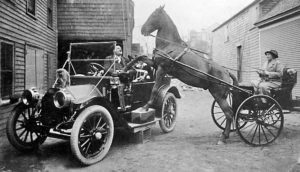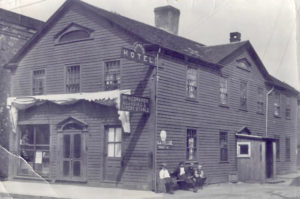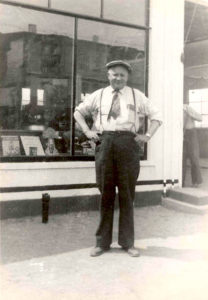The Later History
1781–1818: The Sinclair Family
Frederick Zeiglar, a German immigrant, was in Granville by the mid 1760s, having purchased 500 acres (Lot #65) from Elias Davis for “two cows in full of all demands”. He purchased a substantial amount of land in both Granville and Annapolis, and often provided mortgages to borrowers. He was referred to as “Colonel” and had the prefix “gentleman” in one of the deeds, so it is likely that he was reasonably wealthy and respected. His name soon became anglified to Sinclare/Sinclaire/Sinclair.
The Sinclair Inn became in the early years an important centre of activity, not only as a tavern and a place to rent a bed, but also as the location of court-ordered property auctions carried out by the High Sheriff of Annapolis County. This activity would continue well into the early 1800s.
An interesting transaction took place on February 24, 1787, when Richard Betts of New York, for 21 pounds, sold to Frederick Sinclair of Annapolis “a negro wench named Jane…”. Jane likely spent time at the Sinclair Inn as she carried out her master’s duties.
Sometime before 1800 Frederick Sinclair yearned to return to his homeland. He advertised his properties in Annapolis and Granville for sale, saying he wished to return to Hanover, Germany. This yearning may be been brought to a halt by illness. Sinclair died in the latter part of 1799, leaving the Sinclair Inn to his wife, Mary, who continued to operate the business. His daughter, Hannah, wife of Peter Balsor, is mentioned in his will.
Mary Sinclair died in 1814, and her daughter Hannah ran the Inn for a time, but there is no deed or record of the sale of the business. It was probably sold to Thomas Edison, a local carpenter, who promptly sold the property again in 1818 to Antonio Gavaza.
1818–1865: The Gavaza Family and others
Antonio Gavaza, an Italian immigrant, came to Annapolis Royal in the early 1800s, and in 1818, purchased the Sinclair Inn for 350 pounds. In1825 he purchased the adjacent land to the south where he built a large house in which to live and operate his grocery and hardware business. It is not clear whether Antonio or his sons ever participated in the direct operation of the Inn, but it continued to operate as a hotel on a leased basis. Simon Bishop is listed as lessee of the Provincial Hotel, which is what the business was called in 1858, when Antonio’s son Thomas A. Gavaza sold him the Inn for 550 pounds.
Bishop rapidly turned around and sold the Inn to Charles Starratt of Annapolis Royal, who then sold it back to Bishop. By 1859, Simon Bishop was unable to keep up the mortgage payments, and the property was sold by the High Sheriff, Peter Bonnett, at auction. It was purchased by a Halifax firm of merchants, Alexander McLeod, Thomas Bayne and John W. Sinclair, for the lowly sum of 130 pounds. These gentlemen sold the Inn in 1863 to Robert Wyllie of Granville, who then sold it to William Anderson of Annapolis Royal.
1865–1896: The William Anderson Family
William and Mary Anderson operated the hotel under the name of the Temperance House. An advertisement from the local newspaper, the Annapolis Journal, Saturday, February 9, 1878, reflects their philosophy and the services they offered:
ANNAPOLIS
WILLIAM ANDERSON, Proprietor
The subscriber begs leave to inform his friends, and the traveling public generally, that he has opened his house on Temperance Principles, and thanking them for their liberal patronage in the past, hopes they will continue to give him the same patronage in the future.
Good accommodation for permanent and transient boarders.
Good stabling and attentive Hostler.
Terms moderate.
WM Anderson
In 1875, William bought the lot on the north side of the Sinclair Inn. Later his son would sell it to George McLaughlin, who would build a brick building for his business. William died sometime after October 25, 1875, when his will was dated. He left all his property to his wife Mary and his son Eben, who was probably responsible for the operation of the hotel business, which became Anderson’s Hotel. By 1896, the business had become burdensome, and Eben was unable to keep up his mortgage payments. Edwin Gates, High Sheriff, sold the hotel at auction for $1610 to Aubrey S. Hunt and J. Johnstone Hunt, who then sold it within months for $1860 to Hugh Gillis, a local lawyer. Eight days later, on January 12, 1897, Mr. Gillis sold the Inn to David Riordan for $2175.
1897–1922: David Riordan and Bill Edwards
David and Samuel were the sons of Michael and Grace Riordan. The Riordan family had been deeply involved in the hotel business in Annapolis Royal for many years. The family had also owned or managed the Dominion Hotel, the Queen Hotel and the Clifton House. David appears to have operated the Queen Hotel at the same time that he owned the Sinclair Inn. In 1912, Samuel Riordan, who partnered with his brother in operating the Queen Hotel, moved to Vancouver where he purchased the Metropole Hotel. At about the same time, David also moved to British Columbia, where he again operated a hotel, and later moved into ranching.
David Riordan sold the Sinclair Inn to William “Bill” Edwards in 1910. Bill was a big, bluff, colourful character. One of the notable features during his ownership was the monkey which often sat in the window of the Sinclair Inn, and which the local newspaper enjoyed profiling:
Annapolis Spectator
Thursday, July 16, 1914Bill Edwards’ monkey is taking a hand in the political game, and seems to be an ardent Tory, for while he treats the Heraldwith every respect, he cannot stand theMorning Chronicle and tears it up whenever he gets the chance.
Thursday, October 7, 1915
EMPTY IS THE COLLAR, MONKEY’S GONEWhen W.H. Edwards with his monkey on the jib boom of his automobile started for Yarmouth on a sunny morning a day or two ago he was ignorant of the dark thick clouds of grief which were to obscure his particular path of firmament before night. All day Bill and the monkey enjoyed themselves at the exhibition, the monkey especially being in high fettle on account of a toy balloon which his master has kindly bought for him. But after poor Jack again mounted the car to return home, and it was in motion, by some mistake he slipped and fell, the car passed over him, and he was no more. Bill was much upset by the shock of losing his little favorite, but he picked up the poor little body and it is rumored that Jack will be stuffed and will again be an ornament to the office.
Bill was also known for his interest in horses:
Thursday, May 29, 1919The death of a great and good old friend was mourned by W.H. Edwards and many others about town this week when it was known that Bill’s famous old horse “Pat” had died on Sunday morning. He was about 20 years old and was credited with knowing everything a horse could know. His photograph on the Farmers’ Hotel calendars adorns the offices of many. “Pat” had been sick off and on all winter and the owner had consulted Dr Sims of Paradise, who arrived by auto but not in time to save the highly prized animal. Allowed out in the morning, he walked slowly about visiting his old haunts and finally went over and shook hands with John McKay, Chief of Police, and at once returned to his premises and expired. His remains were taken to the farm of the owner accompanied by the Vet above referred to who held a post mortem examination in the presence of Jas Spinnery, Ernest Banks, R.H. Hardwick and Harry Gormley.
Bill Edwards sold the Hotel in 1922 and died in 1923.
1922–1954: Lalia Wallace and the Stewart Mills family
Little is known of James and Lalia Wallace who came from Middleton to operate the Annapolis Royal Hotel until 1938 when they sold the business to Stewart and Jean Mills.
Stewart Mills was born in Granville in 1890. In his early working years he carried the mail from Victoria Beach to Annapolis Royal. He likely began soon after that to expand into a variety of business areas, such as buying and selling pulpwood and firewood, along with hauling materials wherever and whenever required.
He must have had adequate funds and stature in the community, because in 1931, Ford Motor Company gave him the dealership for Ford cars in Annapolis County. In 1934, he and his wife Jean purchased the Sinclair Inn, which she would operate quite effectively despite having a family of three children. The Sinclair Inn had a large number of rooms, and contained a sizeable dining room. At the rear of the Sinclair Inn was a large old barn which ran athwart (north and south) the Inn itself. Stewart may have used this barn for repair and body work for the Ford dealership. There was a narrow roadway between the Sinclair Inn and the building just to the south of it.
In the late 1930s, Stewart Mills purchased property across the street, which Irving Oil subsequently bought to build a service station. Stewart leased the service station, and it would be not only the centre of his Ford Motor dealership, but also the location of his office, from which he operated all his businesses. These included mail transport, the Ford dealership, trucking, a taxi operation, a rooming house, and then in the 1940s, bus transportation. Mills started with a bus that travelled between Victoria Beach and Annapolis Royal. Later he would own and operate Wagner Tours, which carried passengers between Annapolis Royal and Digby before the predecessor of Acadian lines took over the operation.
One regular source of income for the Sinclair Inn was the visits of deep sea ships which were loading pulp wood. Crew members would stay at the hotel, rather than on board ship.
In 1944, Ralph Wagner obtained a job working for Stewart Mills. His first job was trucking slab wood which Stewart purchased from the Tom Fortier mill, and then sold to customers in the surrounding areas. Ralph remembers Stewart sending off loads of wood to certain families who had little or no money. Stewart would tell Ralph to take any money he could get, but if the family couldn’t pay, leave the wood there. “Stewart was a generous man.” Ralph was soon doing other things for Stewart, including driving the Wagner Tours buses to Digby and back, driving taxi (a ‘39 Mercury), and also doing a bit of mechanical work in the garage.
Stewart Mills was a bluff, confident, heavy-set man who would wear a dark suit jacket all year, even on the warmest days in summer. He always carried a huge roll of bills in his suit pocket, and this was evident to all who saw him. He was what would be called a “wheeler dealer” today. If he saw a stack of cordwood or firewood that someone wanted to sell for ready money, he would peel off a few bills from his roll, and the deal was done. He seems to have been active in most phases of the business, with the possible exception of the hotel where Jean was the “head honcho” and a “damn good manager”. If there were no one around to drive the taxi, he would hop in and take care of a call. Ralph Wagner recalls getting into the taxi one day when he saw this huge roll of bills lying there on the seat. Ralph, who was making about fifty cents a day, thought that he could have become rich – just like that! But he immediately returned the money to Stewart, who was not worried about it all – “must have dropped out of my pocket”, was all he had to say. One of Stewart’s sidelines (the town did not have a pub or licensed premises) was to keep a stock of liquor for sale in the service station, on an “as required” basis. It was relatively open, and no action was ever taken against this activity. Strangely, Stewart was a teetotaller, and the Sinclair Inn had no liquor facilities.
In 1945, Ralph Wagner heard about a five-year old Ford two-ton for sale. He wanted to buy it, but he had absolutely no money. He eventually screwed up his nerve and asked Stewart if he would loan him $1000, the price of the truck. There was no hesitation. Stewart pulled out his ever-present wad of money and peeled off ten $100 bills, gave them to Ralph and told him to buy the truck. There was no paper work or repayment schedule. Ralph did buy the truck and went off to work on the Liverpool Road, and every two weeks he would come in and hand Stewart a payment, until the loan was paid off. Ralph always remembered Stewart as a “prince of a man and a gentleman”.
Stewart died in late 1956 of pneumonia in the Annapolis General Hospital. With Stewart gone, Jean Mills and her family put the Sinclair Inn on the market, and it was never to return to its main operation as a hotel.
Ruth Eisenhauer then purchased the building. The front was used for Foster Stevenson’s taxi business and other small retail operations. But it was not maintained, and the Sinclair Inn began its long period of deterioration, which would last until Heritage Canada stabilized the building in the early 1980s.
1980s–present
In the early 1980s, a major re-development of the Annapolis Royal downtown area took place. The historical importance of the Sinclair Inn became evident, and in 1981 the Heritage Canada Foundation purchased the building. A substantial amount of work was done on the building to stabilize it. About the same time it was designated as a Provincial Heritage building. In 1984 the Historic Restoration Society (now the Annapolis Heritage Society) took over ownership of the building. It was not until about the mid 1990s, however, that a committee was formed to consider the future of the building. By the late 1990s, Historic Restoration Society had decided to interpret the building, and an interpretative plan was prepared. In 2000, a Millennium grant of $43,500 was provided by the federal government to assist with work on the building. At the same time, the Provincial government gave $20,000, and the George Cedric Metcalfe Foundation granted another $20,000. In 2003, the Atlantic Canada Opportunities Agency provided a major gift of $159,000. The Annapolis Heritage Society has invested about $80,000 in cash and untold volunteer hours to bring this interesting old building into the eye of the public.












